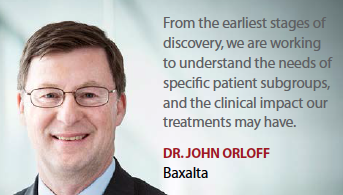 President Obama unveiled early in 2015 the Precision Medicine Initiative, an effort to revolutionize medicine and generate the scientific evidence needed to move the concept of precision medicine into everyday clinical practice. With a $215 million investment in the President’s 2016 budget, the Precision Medicine Initiative aims to develop a new model of patient-powered research that promises to accelerate biomedical discoveries and provide clinicians with new tools, knowledge, and therapies to select which treatments will work best for which patients.
President Obama unveiled early in 2015 the Precision Medicine Initiative, an effort to revolutionize medicine and generate the scientific evidence needed to move the concept of precision medicine into everyday clinical practice. With a $215 million investment in the President’s 2016 budget, the Precision Medicine Initiative aims to develop a new model of patient-powered research that promises to accelerate biomedical discoveries and provide clinicians with new tools, knowledge, and therapies to select which treatments will work best for which patients.
In September, the National Institutes of Health Advisory Committee presented a detailed design framework for building a national research participant group, called a cohort, of Americans to expand knowledge and practice of precision medicine. The NIH plans to move quickly to build the infrastructure so that participants can begin enrolling in the cohort in 2016, with a goal of enrolling at least 1 million participants in three to four years.
The establishment of a cohort will enable the development of quantitative estimates of risk for a range of diseases by integrating environmental exposures, genetic factors and gene-environment interactions and create a platform to enable trials of targeted therapies.
NIH will lead efforts in cancer genomics, as well as the development of the participant cohort. Of the total proposed in FY2016, $130 million was allocated to NIH to build the research cohort.
The Potential of Personalized Medicine
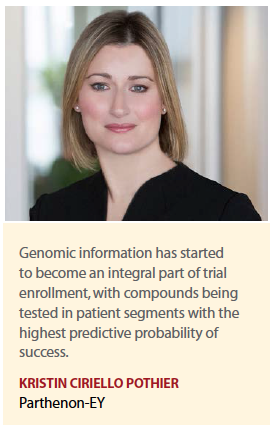 Personalized medicine is finally gaining momentum, and it has the potential to reshape how therapies are developed in the future. Through newer efforts, such as the National Institutes of Health Precision Medicine Initiative, personalized and precision medicine will generate the evidence for disease prevention and treatment based on the genes, environment, and lifestyles of each patient.
Personalized medicine is finally gaining momentum, and it has the potential to reshape how therapies are developed in the future. Through newer efforts, such as the National Institutes of Health Precision Medicine Initiative, personalized and precision medicine will generate the evidence for disease prevention and treatment based on the genes, environment, and lifestyles of each patient.
“The use of new and emerging technologies and techniques within healthcare is providing great insights into the ways diseases work, and informing researchers in how to better combat those diseases," says John Orloff, M.D., executive VP, head of research and development and chief scientific officer, Baxalta.
Oncology is likely to continue to be at the forefront of precision medicine in terms of potential because of the heterogenic nature of the disease, says Martin Robinson, Ph.D., executive VP and IAOCR Ambassador.
“Looking further into the future of immunotherapeutic agents, transplant-related treatments and infectious diseases are where we may be likely to see the next breakthroughs," he says. “The need to administer specific treatments to distinct subgroups of patients is likely to make clinical trials more complex. Specialist skills will need to be developed to support the conduct of this research and sponsors and investigators alike will need to have staff with relevant specific competencies. CROs could create expert teams to set up and run trials of this nature for their sponsor clients."
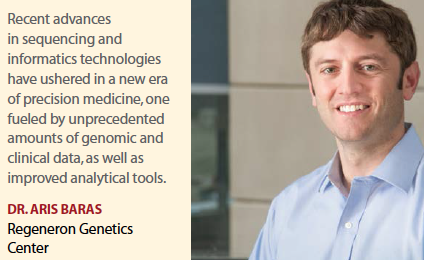 The potential for precision medicine to improve care and speed the development of new treatments has only just begun to be tapped. Translating initial successes to a larger scale will require a coordinated and sustained national effort.
The potential for precision medicine to improve care and speed the development of new treatments has only just begun to be tapped. Translating initial successes to a larger scale will require a coordinated and sustained national effort.
Patient-centric research relies on continued and sustained partnership of the various stakeholders to amass the data necessary to characterize the disease in all its dimensions, translate this data rapidly and through leading-edge technologies into findings, then rapidly test these findings in the clinic with the full engagement of the entire patient and provider community to lead new treatments to be available.
With major advances in science, technology, and digital health, companies will be increasingly able to implement disease interception strategies, says Ben Wiegand, head, disease interception accelerator, at Janssen Research & Development.
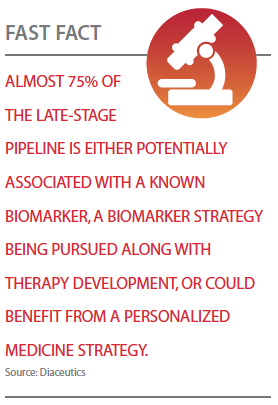 “We can look at biomarkers and phenotypic alterations to identify disease and intervene earlier than today’s clinically accepted point of diagnosis and seek solutions that stop, reverse or inhibit progression to disease," he says. “This isn’t just a futuristic concept; it’s an imperative and a key focus area for Janssen today. Disease interception will mean that in the future, people would no longer be ‘patients’ as we use the term today. We will move away from what is essentially ‘disease’ care to what is truly ‘health’ care."
“We can look at biomarkers and phenotypic alterations to identify disease and intervene earlier than today’s clinically accepted point of diagnosis and seek solutions that stop, reverse or inhibit progression to disease," he says. “This isn’t just a futuristic concept; it’s an imperative and a key focus area for Janssen today. Disease interception will mean that in the future, people would no longer be ‘patients’ as we use the term today. We will move away from what is essentially ‘disease’ care to what is truly ‘health’ care."
Jeffrey Spaeder, M.D., chief medical and scientific officer at Quintiles, says the science and the economics are aligning to make sub-stratification of disease phenotypes a viable development pathway.
“While such stratification allows for maximization of the benefit-risk profile of a new therapy, it also increases the complexity of the studies and increases the number of patients needed to be screened to identify those with the stratification most likely to benefit from a therapy," he says. “Beyond the use of stratification for conducting a specific study there is an increasing realization that effectively utilizing data beyond an individual study, to guide a portfolio or development pathway, is one way to make more informed decisions not only for a particular therapy but for a portfolio."
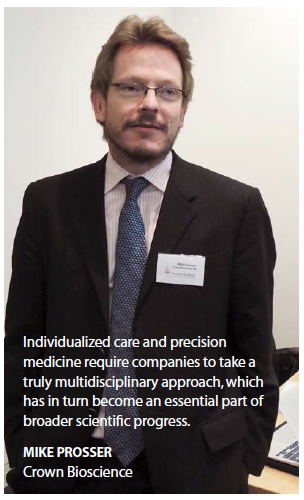 But Mike Prosser, general manager, Europe, of Crown Bioscience, stresses that answering fundamental biological cancer questions, such as understanding the mechanisms behind a cell becoming abnormal, losing adhesion or its ability to stop dividing, requires relevant animal models.
But Mike Prosser, general manager, Europe, of Crown Bioscience, stresses that answering fundamental biological cancer questions, such as understanding the mechanisms behind a cell becoming abnormal, losing adhesion or its ability to stop dividing, requires relevant animal models.
“Genetically engineered mouse models have significantly contributed to our understanding of cancer biology, from validating gene functions to identifying novel cancer genes and tumor biomarkers," he says. “These models allow researchers to gain insight into the molecular and cellular mechanisms underlying tumor initiation and the multistage processes of tumorigenesis, providing better preclinical models in which to test novel therapeutic strategies. However, mice still have significant limitations in modeling human cancer, including species-specific differences and inaccurate recapitulation of de novo human tumor development. Future challenges include the generation of mouse models that capture both, the molecular, cellular and genomic events of human cancers and the associated clinical response, as well as the development of technologies that allow for efficient in vivo imaging and high-throughput screening in mice."
Impact of Precision Medicine on R&D
Precision medicine’s impact on R&D is palpable, says Kristin Ciriello Pothier, partner and head of life sciences, Parthenon-EY.
“The proportion of pharma pipelines that include precision medicine-based targeted therapies is at an all-time high and continues to grow," she says. “More than 60% of the oncology pipeline is targeted, meaning the drug is affecting specific molecular targets such as BRAF, harnessing the immune response to attack cancer cells such as the PD-1s, or affecting specific proteins or pathways important to cancer biology such as Hedgehog. Other indications such as neurology and cardiovascular are following suit."
Ms. Pothier says this pipeline shift has changed how pharma approaches its R&D.
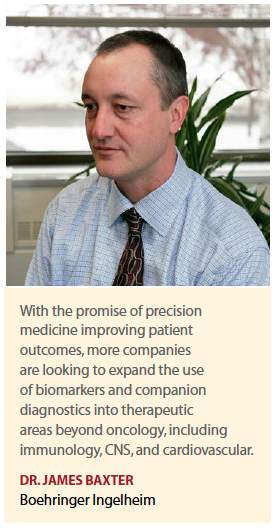 “We can now enrich patient populations for clinical trials, a method proven to eliminate the background noise, thus increase probability of success, enable smaller sizes, and faster times to market," she says. “Because of this, genomic information has started to become an integral part of trial enrollment, with compounds being tested in patient segments with the highest predictive probability of success. Additionally, the genomic and clinical outcome data from the trials and the real-world experience from drug use must be fed into continuous learning algorithms to further refine where drugs should be used on an ongoing basis."
“We can now enrich patient populations for clinical trials, a method proven to eliminate the background noise, thus increase probability of success, enable smaller sizes, and faster times to market," she says. “Because of this, genomic information has started to become an integral part of trial enrollment, with compounds being tested in patient segments with the highest predictive probability of success. Additionally, the genomic and clinical outcome data from the trials and the real-world experience from drug use must be fed into continuous learning algorithms to further refine where drugs should be used on an ongoing basis."
The building blocks of precision medicine have been guiding R&D strategies for a long time, namely through the pursuit of deeper molecular understanding of health and disease, says Aris Baras, M.D., executive director and co-head, Regeneron Genetics Center.
“Recent advances in sequencing and informatics technologies have ushered in a new era of precision medicine, one fueled by unprecedented amounts of genomic and clinical data, as well as improved analytical tools," Dr. Baras says. “These advances have already paved the way for new validated drug targets, a more quantitative and molecular basis of understanding diseases and potentially improved success rates in drug development.
“We believe that R&D strategy should focus on developing new resources and leveraging large-scale genomic datasets through internal initiatives and external partnerships with academia and health systems," Dr. Baras continues. “All of this early research and analysis should be done with an eye toward broadening and integrating capabilities across genomic and data sciences, deep biology and functional validation, and, ultimately, the downstream development of new treatments for patients in need."
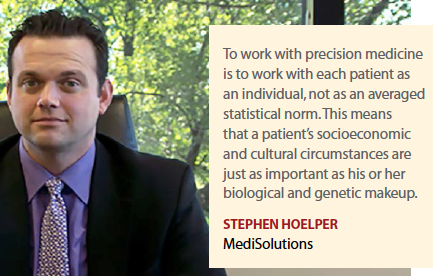 The Regeneron Genetics Center, a division of Regeneron Pharmaceuticals launched in January 2014, builds upon Regeneron’s strengths in mouse genetics and genetics-driven drug discovery and development. The center aims to reveal, on a large scale, genetic factors that cause or influence a range of human diseases.
The Regeneron Genetics Center, a division of Regeneron Pharmaceuticals launched in January 2014, builds upon Regeneron’s strengths in mouse genetics and genetics-driven drug discovery and development. The center aims to reveal, on a large scale, genetic factors that cause or influence a range of human diseases.
“We believe in a multi-faceted approach, but with everything rooted in genetics," says Alan Shuldiner, M.D., VP and co-head, Regeneron Genetics Center. “We think it’s important to look at diverse sets of genomic data, including large-scale populations like the Geisinger Health System cohort, families with rare diseases, and isolated founder populations, such as the Amish or Icelandic populations. Vast amounts of genomic data paired with their phenotypes, or real-world health records, help us understand who gets various diseases, and, equally important, who may be protected from them."
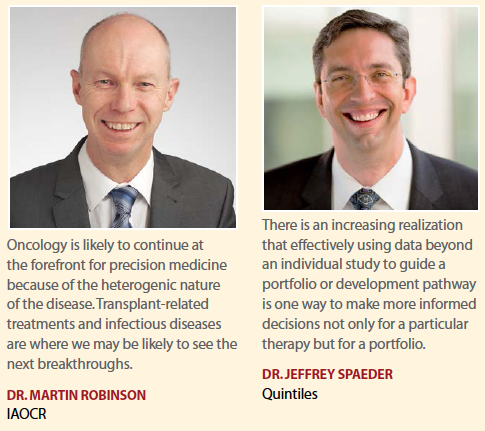 In 2014, Regeneron and Geisinger launched a large-scale initiative to sequence 100,000 consented participants, linking genomic data to de-identified electronic medical record data to enable large-scale gene discovery at an unprecedented scale. The effort has sequenced almost 50,000 participants by June 2015.
In 2014, Regeneron and Geisinger launched a large-scale initiative to sequence 100,000 consented participants, linking genomic data to de-identified electronic medical record data to enable large-scale gene discovery at an unprecedented scale. The effort has sequenced almost 50,000 participants by June 2015.
Another collaboration is with Baylor College of Medicine and the Human Genome Sequencing Center to study the genetic basis of Mendelian diseases in a unique collaboration of large-scale sequencing projects and functional genomics capabilities. With Columbia University Medical Center, RGC is studying the genetic basis of familial forms of various diseases, including inherited cardiometabolic diseases, cancer predisposition and rare diseases.
Baxalta is another company that is using the power of precision medicine in its drug development. The biological and data-driven insights driving the move to precision medicine are having a deep impact on all of Baxalta’s R&D activities, and commercial strategies as well, Dr. Orloff says.
“From the earliest stages of discovery, we are working to understand the needs of specific patient subgroups, and the clinical impact our treatments may have," he says. “Our guiding principle is that we want to develop medicines that have a meaningful impact on the lives of the vast majority of people who use them, rather than pursue an all comers blockbuster approach that defined large pharma R&D for so long. We look to develop deep biological insights early on, helping to stratify patient populations and clarify the focus of our R&D strategies using clinically meaningful disease biomarkers. As we proceed through development this approach allows us to speed our development timelines and improve R&D productivity. Our clinical trials can be more focused and be designed to demonstrate an impact on disease parameters that are well characterized and well understood. Ultimately, as we approach the marketplace, demonstrating the impact of our therapies in a clinically meaningful way will be an essential asset in our value message to payers."
An example is the work Baxalta is doing in gene therapy, advancing a treatment for hemophilia B. Patients with hemophilia B suffer from an inability to produce clotting factor IX, which can cause bleeding episodes, hemophilic arthropathy (bleeding into a joint) and/or hospitalization. The current standard of care to treat this disease uses infusions of plasma-derived or recombinant factor IX, a corrective measure that treats the condition and which requires ongoing and frequent infusions.
“But a new approach we’re pursuing using gene therapy has allowed us to view hemophilia B through a different lens entirely, in which we don’t just treat the condition, but work to address the underlying genetic problem that causes it," Dr. Orloff says. “We do this by introducing a mechanism for a patient’s own liver to begin producing factor IX following a single dose of treatment. While we’re still in the early stages of R&D, this is a great example of the ways in which a deep understanding of diseases themselves is allowing us to not only offer condition management to our patients, but also potentially transform the treatment paradigm altogether."
With the promise of precision medicine improving patient outcomes, more companies are looking to expand the use of biomarkers and companion diagnostics into therapeutic areas beyond oncology, including immunology, CNS, and cardiovascular, says James Baxter, Pharm.D., Ph.D., senior VP of development at Boehringer Ingelheim Pharmaceuticals.
“We’re seeing companies build meaningful biomarker and companion diagnostic programs for R&D, and establishing criteria to determine when to make the investment of taking a drug candidate into human trials, and from there into the large and expensive Phase II/III studies," Dr. Baxter says.
“Overall, precision medicine will become more embedded in drug development in certain disease areas, and all companies will need to do this as they strive to stay competitive. Companies are also developing strategies about how to build biomarker and diagnostic capabilities, determining what will be developed and managed in-house versus through partnerships."
Patient organizations, as well, are involved in precision medicine efforts. For example, the Multiple Myeloma Research Foundation established the MMRF CoMMpass Study in 2011 with the goal of enrolling 1,000 patients who would provide tissue samples when first diagnosed, and then each time there was a change in their treatment.
This effort is already starting to reveal insights into this blood cancer. In March 2015, the MMRF released an interim analysis of the complete genomic sequencing data from 190 patients and clinical data from 420 patients enrolled in CoMMpass.
The analysis identified new genomic changes, including many that may be associated with disease onset.
Complex genomic changes, called rearrangements, were identified that result in aberrant expression of genes in signaling pathways that are believed to be important for disease initiation and progression, such as the NF-kappaB, BCL2/apoptotic and the mitogen-activated kinase pathways.
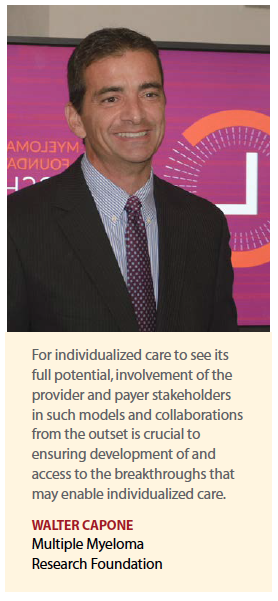 “The MMRF has built an end-to-end drug development accelerator system that begins with acute awareness of patient need and expedites novel therapeutic options to extend and improve patient’s lives," says Walter Capone, president and CEO of the Multiple Myeloma Research Foundation. “This system envisioned the incorporation of precision medicine into the drug development process and acceleration of new treatments to patients from the outset in 2004, just following the mapping of the human genome. By providing more information upfront on disease biology, we can better characterize individual disease biomarkers. Researchers can then use this information to design trials with drugs that target specific disease markers and therefore, enrich patient population for better outcomes."
“The MMRF has built an end-to-end drug development accelerator system that begins with acute awareness of patient need and expedites novel therapeutic options to extend and improve patient’s lives," says Walter Capone, president and CEO of the Multiple Myeloma Research Foundation. “This system envisioned the incorporation of precision medicine into the drug development process and acceleration of new treatments to patients from the outset in 2004, just following the mapping of the human genome. By providing more information upfront on disease biology, we can better characterize individual disease biomarkers. Researchers can then use this information to design trials with drugs that target specific disease markers and therefore, enrich patient population for better outcomes."
Mr. Capone says the MMRF model, which can apply across different types of cancers, involves collaborations with leaders in precision medicine from industry, institutions, and academia, building a new research platform from the ground up, first sequencing the myeloma genome, and then designing and launching the largest longitudinal research study ever conducted in our disease.
Impact on Patient Care
Dr. Orloff says the value of collaboration from all those involved in the healthcare system is critical to achieving better solutions for patients.
“As a biopharmaceutical company, we are charged with bringing all stakeholders together, using their insights and knowledge and responding to their needs by consistently providing innovative treatment options," he says. “At Baxalta, we have really embraced this charge through the adoption of our external innovation model, which is focused on leveraging the best partners and experts within our industry to collaboratively advance the latest therapies and achieve sustainable growth, with an uncompromised focus on patients’ needs and experiences. To us, this means bringing the best experts in the industry to our company to advance treatment options; partnering with the best people in the business to benefit from their skills and expertise; and listening to the feedback and needs of our patients, those providing them with treatment, and patient advocacy organizations, to ensure that our priorities and the approaches we take to achieve those priorities are addressing the needs of those receiving our treatments. Thus, our charge is to be the conduit for all this insight and information that turns that knowledge into tangible solutions."
Dr. Spaeder says the more care becomes individualized, the more the patient becomes an active participant, and to be a participant, patients need to be informed and educated about the process.
“But most importantly they need to trust the other partners in their care," he says. “Patients need to trust that the personalized data that they provide will be used appropriately and that the interests of all involved stakeholders — researchers, payers, healthcare providers, government, etc. — are aligned with the patient."
The patient experience is become the driving force of all adherence, communication, and care strategies, says Stephen Hoelper, VP of marketing and new product development, MediSolutions.
“Precision medicine initiatives such as pharmacogenomics are a core element of this shift," he says. “Such diagnostics allow healthcare providers to ensure that patients are correctly metabolizing drugs. For patients, this means fewer side effects and correct dosing — a better experience. For industry, this feedback and aggregated data allow drugs to be developed for greater impact across wider demographics."
Mr. Hoelper says to gain momentum, the industry can’t think about millions of patients at the same time.
“To work with precision medicine is to work with each patient as an individual, not an averaged statistical norm," he says. “This means that a patient’s socioeconomic and cultural circumstances are just as important as their biological and genetic makeup. Thus, the big challenge remains in making companion diagnostics affordable and available. Doctors remain the crucial link between patients and life science companies."
Dr. Robinson says patients must have the reassurance that research using this new approach is going to be ethical, particularly in the use of potentially sensitive information.
“Patients must have confidence in medical professionals in their ability to handle data so that patient privacy and confidentiality is maintained," he says. “Rules on biological sample storage and retention must be strictly adhered to. Patients must be well informed. Only then will they feel empowered to participate and contribute to this new era of medicine."
Mr. Prosser says individualized care and precision medicine is an innovative approach that takes into account differences in people’s genes, environments, and lifestyles. Such complexity requires companies to take a truly multidisciplinary approach, which has in turn become an essential part of broader scientific progress. Examples of relevant areas for personalized medicine include proteomics, metabonomics, epigenomics, and pharmacogenomics.
One pharmaceutical company working hard to make patients and consumers the center of its focus is Bristol-Myers Squibb, which recently launched WorkingTogetherforPatients.com. The company works with advocacy groups to match patients with clinical trials, with a special emphasis in the area of diversity.
“We are working with minority-focused physician groups to bring awareness into the community about oncology and other therapeutic areas," says Lori Abrams, director, diversity and patient engagement at Bristol-Myers Squibb (BMS). “We’re focusing on diseases that have high prevalences in the African-American and other ethnic communities."
Ms. Abrams group was started three years ago and works to bring accessibility and awareness of the company’s clinical trial to various patient groups.
“The demographics of our population are changing," she says. “Over the next 20 years, we’re going to see a shift in who are the minorities. We have an ethical obligation to make sure that our medicines work the same way in each ethnic and racial minority, age range and gender. From that perspective, it’s important to know the safety profile as well as whether the medicines are efficacious in all the different demographics. “
Another effort at the company is a new team called the Patient Hub, which aims to be stewards of patient experience. One of the group’s main objectives is to bring best practices and improve ways of providing information to patients, so that it is understandable and actionable.
“We recognize that the role of the patient is continuing to increase," says Elizabeth Turcotte, director of the Patient Hub at BMS. “That spans a variety of dimensions. All of us as patients are expected to take a much more active role in taking charge of our health and participating in the decisions."
One project of the group is the Universal Patient Language, which kicked off in May 2014 and is a set of resources developed to help communicate with patients about complex topics. The UPL offers clear guidance on what information to present to patients, and how to do it in a way that’s fair, accurate, understandable and which addresses patients’ needs.
“We’re trying to establish images and icons to help supplement our explanation of concepts," Ms. Turcotte says. “We’re a research company. Communicating with patients is a completely different way of communicating. As the role of the patient is becoming increasingly important to us from the business perspective, it is a very different skill set and a very different area of expertise." (PV)

















